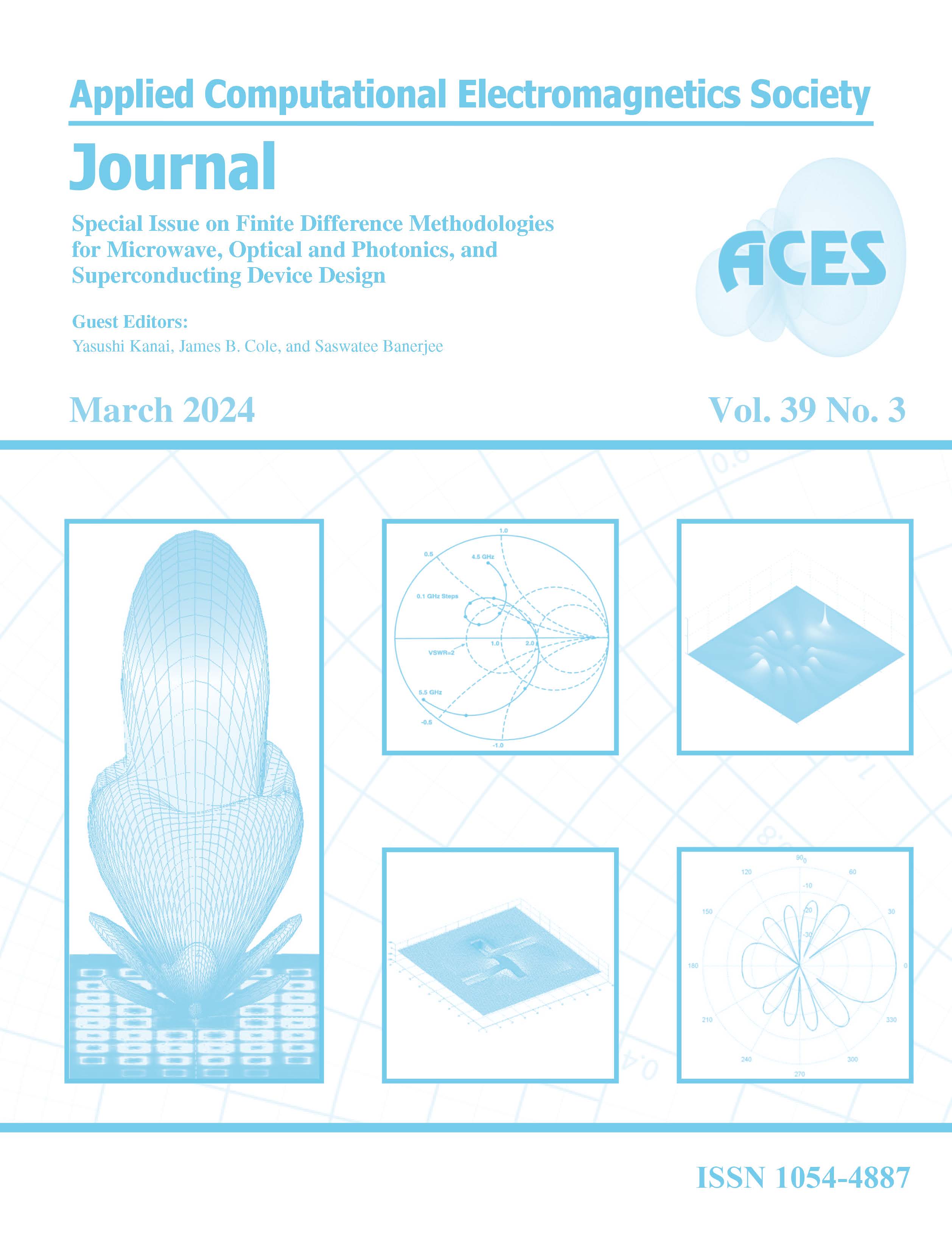Wideband Simultaneous Dual Circularly Polarized Phased Array Subarray with Scalable Characteristics for Satellite Communications
DOI:
https://doi.org/10.13052/2024.ACES.J.390310Keywords:
Modular, phased array, simultaneous dual circular polarization, widebandAbstract
This paper proposes a budget-friendly, highly integrated, and low-profile wideband simultaneous dual circularly polarized phased array subarray with scalable characteristics for satellite communications. In order to achieve wideband, the antenna unit is not only fed by double-fed point probe contact, but also by electromagnetic coupling. Moreover, the dual circularly polarized radiation of the antenna unit is realized by a miniaturized 3 dB bridge-type phase-shift network. In addition, the phased array subarray uses metalized vias to reduce inter-element crosstalk, which effectively improves the active voltage standing wave ratio (VSWR) and beam steering characteristics. Also, the subarray has interchangeability and versatility, enabling convenient two-dimensional expansion to form a tile-type phased array antenna. Besides, the phased array subarray can be used to achieve two-dimensional ±40∘ beam scanning in both the azimuth and elevation planes. Within ±40∘ beam scanning, the active VSWR of the subarray is less than 2.5 in 9.55 - 14.35 GHz (40.17%). At 12.1 GHz, the two-dimensional gain decreases by less than 2.1 dB and 1.95 dB, respectively. The proposed antenna exhibits good performance in terms of matching and beam steering characteristics, which make it suitable for use in future 5G/6G phased array antenna systems.
Downloads
References
G. Gültepe, T. Kanar, S. Zihir, and G. M. Rebeiz, “A 1024-element ku-band SATCOM phased-array transmitter with 45-dBW single-polarization EIRP,” IEEE Transactions on Microwave Theory and Techniques, vol. 69, no.9, pp. 4157–4168, 2021.
S. Rao, M. Tang, and C.-C. Hsu, “Multiple beam antenna technology for satellite communications payloads,” Applied Computational Electromagnetics (ACES) Journal, vol. 21, no. 3, pp. 353–364, 2022.
C.-N. Chen, Y.-H. Lin, L.-C. Hung, T.-C. Tang, W.-P. Chao, C.-Y. Chen, P.-H. Chuang, G.-Y. Lin, W.-J. Liao, Y.-H. Nien, and W.-C. Huang, “38-GHz phased array transmitter and receiver based on scalable phased array modules with endfire antenna arrays for 5G MMW data links,” IEEE Transactions on Microwave Theory and Techniques, vol. 69, no. 1, pp. 980–999, 2021.
L.-H. Ye, Y.-J. Li and D.-L. Wu, “Dual-wideband dual-polarized dipole antenna with t-shaped slots and stable radiation pattern,” IEEE Antennas and Wireless Propagation Letters, vol. 21, no. 3, pp. 610–614, 2022.
Q. Xu, S.-B Liu, Y.-X Wang, L. Song, and H. Cao, “Dual-polarized antenna based on printed dipole and microstrip patch,” Journal of Electronics & Information Technology, vol. 39, no. 7, pp. 1764–1768, 2017.
M. Kanagasabai, P. Sambandam, M. G. N. Alsath, S. Palaniswamy, A. Ravichandran, and C. Girinathan, “Miniaturized circularly polarized UWB antenna for body centric communication,” IEEE Transactions on Antennas and Propagation, vol. 70, no. 1, pp. 189–196, 2022.
Q.-C. Ye, J.-L. Li, and Y.-M. Zhang, “A circular polarization-reconfigurable antenna with enhanced axial ratio bandwidth,” IEEE Antennas and Wireless Propagation Letters, vol. 21, no. 6, pp. 1248–1252, 2022.
J. Zhang and H. Wu, “Simultaneous transmit and receive phased array system architecture and prototype comprehensive verification,” Applied Computational Electromagnetics (ACES) Journal, vol. 37, no. 12, pp. 1257–1264, 2023.
H.-C. Yang, X.-Y. Liu, Y. Fan, and L.-P. Xiong, “Dual-band textile antenna with dual circular polarizations using polarization rotation AMC for off-body communications,” IEEE Transactions on Antennas and Propagation, vol. 70, no. 6, pp. 4189–4199, 2022.
M. Li, Z.-H. Zhang, M.-C. Tang, L. Zhu, and N.-W. Liu, “Bandwidth enhancement and size reduction of a low-profile polarization-reconfigurable antenna by utilizing multiple resonances,” IEEE Transactions on Antennas and Propagation, vol. 70, no. 2, pp. 1517–1522, 2022.
B. Liu, S.-M. Gu, M.-X. Meng, K.-Y. Shi, K.-Q. Ding, L. Xu, Y.-T. Yang, and Y.-L. Chen, “A circularly polarized wide-scan waveguide slot phased array antenna with high efficiency for ka band application,” Journal of Electronics & Information Technology, vol. 43, no. 6, pp. 1630–1636, 2021.
Y.-S. Zhang, W. Hong, Z.-D. Ding, L. Yang, C. Zhu, and Y. Hu, “Circularly polarized metasurface phased array antenna system with wide axial-ratio beamwidth for LEO mobile satellite communication,” IEEE Transactions on Antennas and Propagation, vol. 71, no. 6, pp. 4823–4833,2023.
S. Tiwari, A. K. Singh, A. K. Poddar, U. L. Rohde, and A. Dubey, “Active beamsteerable digital metasurface lens antenna for millimeter-wave applications,” IEEE Antennas and Wireless Propagation Letters ( Early Access ), 2023.
C. Ni, Z.-K. Yu, L. Zhang, and Z.-X. Zhang, “A wide-band circularly polarized and beam deflection antenna based on two metasurfaces,” IEEE Antennas and Wireless Propagation Letters (Early Access ), 2023.
Z.-N. Chen, X.-M. Qing, X.-L. Tang, W. Liu, and R.-L. Xu, “Phased array metantennas for satellite communications,” IEEE Communications Magazine, vol. 60, no. 1, pp. 46–50, 2022.
C. A. Reddy, K. V. Janardhanan, K. K. Mukundan, and K. S. V. Shenoy, “Concept of an interlaced phased array for beam switching,” IEEE Transactions on Antennas and Propagation, vol. 38, no. 4, pp. 573–575, 1990.
D. M. Pozar, “A relation between the active input impedance and the active element pattern of a phased array,” IEEE Transactions on Antennas and Propagation, vol. 51, no. 9, pp. 2486–2489, 2003.




